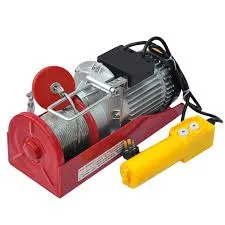


Chain Hoist Operation A Comprehensive Guide
Chain hoists are indispensable tools in various industries, known for their reliability and efficiency in lifting heavy loads. Whether in construction, manufacturing, or warehousing, understanding the operation of a chain hoist is crucial for ensuring safety and maximizing productivity. This article provides a comprehensive overview of chain hoist operation, covering key components, operating procedures, safety measures, and maintenance tips.
Understanding Chain Hoists
A chain hoist consists of a chain, a hook, a pulley, and a lifting mechanism, typically operated either manually or electrically. The hoist allows users to lift and lower heavy objects with relative ease. Manual chain hoists rely on the operator’s physical effort combined with a hand chain, while electric chain hoists utilize an electric motor to perform the lifting action.
Key Components 1. Chain The primary lifting medium, which connects the load to the hoist. 2. Hook A secure point for attaching the load; it’s designed to hold heavy weights safely. 3. Pulley A grooved wheel that guides the chain and can change the direction of the lifting force. 4. Drive Mechanism For electric hoists, this includes the motor and gear system that drives the chain. 5. Brake System Essential for holding the load in place when not in motion.
Operating Procedures
Operating a chain hoist requires careful attention to detail to ensure efficiency and safety. Here’s a step-by-step guide to using a chain hoist
1. Inspection Before using a chain hoist, inspect all components for wear and tear, including the chain, hooks, and brakes. Ensure the hoist is rated for the weight of the load being lifted.
2. Positioning Place the hoist above the load or at a suitable height to maximize lifting. Ensure the load is on a stable surface and that the path of the load is clear of obstacles.
3. Attaching the Load Securely attach the load to the hook. Check that the load is balanced and properly aligned to avoid any tipping during lifting.

4. Lifting the Load For manual chain hoists, pull the hand chain steadily to lift the load. For electric hoists, activate the motor and control the lift with the push-button pendant. Maintain a clear area around the hoist during this process.
5. Lowering the Load To safely lower the load, gradually release tension on the hoist, whether manually or electronically, allowing it to descend gently.
6. Final Placement Once the load is at the desired height, ensure it is stable before detaching it to prevent any accidents.
Safety Measures
Safety should always be the top priority when operating a chain hoist. Here are some critical safety measures to consider
- Training Operators must receive proper training in hoist operation and safety practices. - Load Limits Always adhere to the manufacturer’s load capacity guidelines; never exceed the rated limit. - Personal Protective Equipment (PPE) Operators should wear appropriate PPE, including gloves, hard hats, and steel-toed boots. - Regular Inspections Conduct regular maintenance and inspections to identify and rectify any issues before operations. - Clear Communication Ensure clear communication among team members during lift operations. Use hand signals or radios if necessary.
Maintenance Tips
Routine maintenance is vital for the longevity and safe operation of chain hoists. Here are some essential maintenance tips
- Lubrication Regularly lubricate the chain and moving parts to reduce friction and wear. - Cleaning Keep the hoist clean and free from debris that may impair functionality. - Storage Store chain hoists in a dry place to prevent rust and corrosion when not in use.
In conclusion, proper understanding and operation of chain hoists are vital for maintaining efficiency and safety in various work environments. By following the guidelines outlined in this article, operators can ensure the effective use of this powerful tool while minimizing risks. Always prioritize safety and maintenance to facilitate a smooth and productive working experience.



